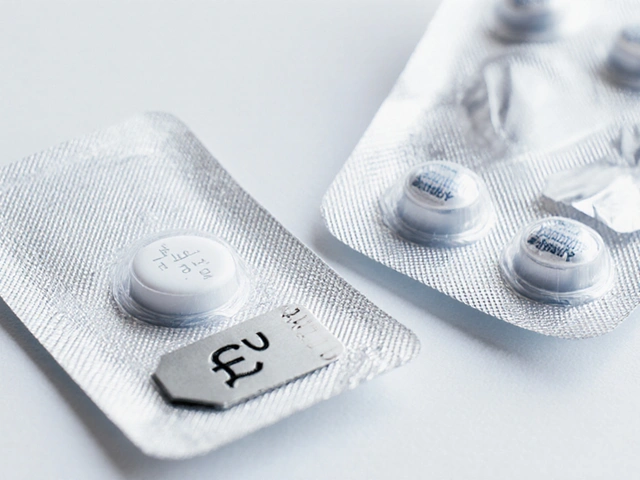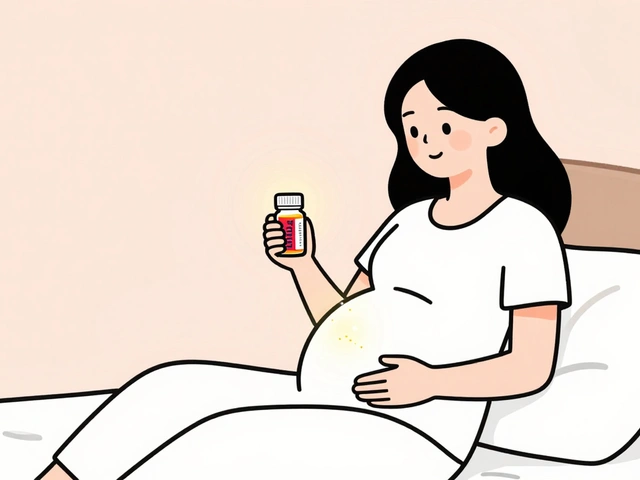Understanding Nifedipine: How It Works, Uses, and What to Watch For

- Colin Hurd
- 28 October 2025
- 15 Comments
Nifedipine isn't just another pill in your medicine cabinet. If you’ve been prescribed it, you’re likely dealing with high blood pressure or chest pain from angina. It’s not a cure, but it’s one of the most commonly used drugs to keep your heart and arteries working smoothly. Unlike some medications that make you feel sluggish or dizzy, nifedipine works quietly-relaxing your blood vessels so your heart doesn’t have to pump as hard. But knowing how it works isn’t enough. You need to know when to take it, what to avoid, and what side effects actually matter.
What Exactly Is Nifedipine?
Nifedipine is a calcium channel blocker. That means it stops calcium from entering the muscle cells in your heart and blood vessel walls. Calcium normally makes these muscles contract tighter. By blocking it, nifedipine lets your blood vessels widen, which lowers your blood pressure and reduces the strain on your heart. It’s not a beta-blocker or a diuretic-it works differently than many other heart medications.
It comes in two main forms: immediate-release (short-acting) and extended-release (long-acting). The extended-release versions, like Adalat CC or Procardia XL, are what most people take today. The old immediate-release pills, which worked fast but caused sharp drops in blood pressure, are rarely used anymore because they increased the risk of heart attacks in some patients. Today’s versions release the drug slowly over 12 to 24 hours, keeping your levels steady.
Why Do Doctors Prescribe It?
Nifedipine is mainly used for two conditions:
- High blood pressure (hypertension): It lowers pressure by relaxing arteries, reducing the risk of stroke, heart failure, and kidney damage over time.
- Angina (chest pain): Especially stable angina, where physical activity or stress triggers chest tightness. By reducing the heart’s workload and improving blood flow to the heart muscle, it prevents these episodes.
In some cases, doctors use it off-label for Raynaud’s phenomenon-a condition where fingers or toes turn white or blue in cold weather due to narrowed blood vessels. Nifedipine helps those vessels stay open. It’s also occasionally used in preterm labor to relax uterine muscles, though this is less common now due to newer options.
How Do You Take It?
Always follow your doctor’s instructions. But here’s what most people need to know:
- Take extended-release tablets whole. Do not crush, chew, or split them. They’re designed to release the drug slowly-breaking them ruins that design and can cause dangerous spikes in medication levels.
- Take it at the same time every day. Consistency matters. Missing doses or taking it irregularly can cause your blood pressure to bounce around.
- You can take it with or without food, but avoid grapefruit or grapefruit juice. It interferes with how your body breaks down nifedipine, raising the drug level in your blood and increasing side effects like dizziness or low blood pressure.
- Extended-release tablets should be taken in the morning. Taking them at night might cause your blood pressure to drop too low while you sleep.
Don’t stop taking it suddenly. If you need to stop, your doctor will slowly reduce your dose. Stopping cold turkey can cause rebound high blood pressure or worsen angina.
What Side Effects Should You Watch For?
Most people tolerate nifedipine well. But side effects do happen-and some are more common than others.
- Swelling in ankles or feet: This is the most frequent side effect. It’s usually mild and not dangerous, but if it becomes painful or one leg swells more than the other, tell your doctor-it could signal something else.
- Dizziness or lightheadedness: Especially when standing up quickly. This happens because your blood pressure drops. Move slowly from sitting to standing.
- Headaches: Often temporary, as your body adjusts to lower pressure.
- Flushing or warmth in the face: A common reaction as blood vessels widen.
- Constipation: Less common than with some other calcium channel blockers, but still possible.
Less common but serious side effects include:
- Fast or irregular heartbeat
- Severe dizziness or fainting
- Signs of liver problems-yellowing of skin or eyes, dark urine, persistent nausea
If you notice any of these, contact your doctor right away. Don’t wait.

What Medications or Supplements Interfere With Nifedipine?
Nifedipine doesn’t play well with everything. Here’s what to avoid:
- Grapefruit juice: As mentioned, it can double your drug levels. Even a single glass can cause problems for hours.
- Other blood pressure meds: Combining it with beta-blockers, ACE inhibitors, or diuretics can lower your blood pressure too much. Your doctor will adjust doses carefully if you’re on multiple drugs.
- St. John’s Wort: This herbal supplement speeds up how your liver breaks down nifedipine, making it less effective.
- Some antibiotics: Like clarithromycin or erythromycin. They slow down nifedipine breakdown, raising the risk of side effects.
- Antifungals: Ketoconazole and itraconazole can have the same effect.
Always tell your pharmacist or doctor about every supplement, herb, or over-the-counter drug you take-even if you think it’s harmless.
Who Should Not Take Nifedipine?
It’s not safe for everyone:
- People with severe aortic stenosis: This is a narrowing of the main heart valve. Nifedipine can make it worse.
- Those who’ve had a recent heart attack: Especially within the first few weeks. Some studies showed higher risks in this group.
- People allergic to nifedipine or similar drugs: If you’ve had a rash, swelling, or trouble breathing after taking it before, don’t take it again.
- Pregnant women should use it cautiously: It’s sometimes used in preterm labor, but long-term use during pregnancy isn’t well studied. Talk to your OB-GYN if you’re pregnant or planning to be.
If you have liver disease, your doctor may lower your dose. Your liver breaks down nifedipine, and if it’s not working well, the drug can build up in your system.
How Long Does It Take to Work?
Extended-release nifedipine starts lowering blood pressure within 1 to 2 hours, but it takes 2 to 4 weeks to reach its full effect. Don’t expect instant results. If your blood pressure hasn’t improved after a month, your doctor may adjust your dose or add another medication.
For angina, you might notice fewer chest episodes within days. But again, consistency is key. Taking it irregularly means your heart won’t get the steady protection it needs.
What Happens If You Miss a Dose?
If you forget a dose, take it as soon as you remember. But if it’s almost time for your next dose, skip the missed one. Don’t double up. Taking two doses too close together can cause your blood pressure to drop too low.
Set a daily alarm or use a pill organizer. Missing doses is one of the top reasons people’s blood pressure stays high despite taking medication.

Can You Drink Alcohol While Taking Nifedipine?
It’s not recommended. Alcohol also lowers blood pressure. Mixing it with nifedipine can make you feel dizzy, faint, or lightheaded-especially when standing up. If you do drink, keep it light and never on an empty stomach. One drink occasionally is usually fine for most people, but talk to your doctor if you drink regularly.
Is There a Better Alternative?
There are many other options for high blood pressure and angina:
- Amlodipine: Another calcium channel blocker. Often preferred because it causes less swelling and has fewer interactions.
- ACE inhibitors (like lisinopril) or ARBs (like losartan): These are often first-line for people with diabetes or kidney disease.
- Diuretics (like hydrochlorothiazide): Help the body get rid of extra fluid.
- Beta-blockers (like metoprolol): Good for angina and heart rhythm issues.
There’s no single “best” drug. It depends on your age, other conditions, side effects you can tolerate, and what else you’re taking. Many people need a combination of two or three drugs to get their numbers under control.
Monitoring and Long-Term Use
Nifedipine is safe for long-term use. Most people take it for years without problems. But regular check-ups matter:
- Check your blood pressure at home at least once a week.
- See your doctor every 3 to 6 months for blood tests to check kidney and liver function.
- Report any new swelling, chest pain, or unusual fatigue.
Don’t assume everything’s fine just because you’re not feeling symptoms. High blood pressure often has no warning signs-until it causes damage.
Final Thoughts
Nifedipine isn’t flashy. It doesn’t make headlines. But for millions of people, it’s the quiet hero keeping their heart healthy. It works. It’s affordable. And when taken correctly, it saves lives.
The key isn’t just taking the pill-it’s taking it right. Avoid grapefruit. Don’t skip doses. Watch for swelling. Talk to your doctor about other meds you’re on. And don’t stop just because you feel fine. Your heart doesn’t know you feel fine-it only knows whether your blood pressure is under control.
Can nifedipine cause weight gain?
Nifedipine doesn’t directly cause weight gain. But some people notice swelling in their ankles or feet, which can make them feel heavier. This is fluid retention, not fat gain. If you gain more than 2-3 kilograms in a week, tell your doctor-it could mean your heart or kidneys are under extra stress.
Is nifedipine safe for older adults?
Yes, it’s commonly used in older adults, especially for high blood pressure. But seniors are more sensitive to its effects. They’re at higher risk for dizziness, falls, and low blood pressure. Doctors usually start with a lower dose and increase slowly. Regular check-ups are even more important.
Does nifedipine affect sexual function?
Unlike some blood pressure drugs, nifedipine rarely causes sexual side effects like erectile dysfunction or low libido. In fact, by improving blood flow, it may help some men. If you notice changes in sexual function, it’s more likely due to other factors like stress, diabetes, or other medications.
How does nifedipine compare to amlodipine?
Both are calcium channel blockers used for the same conditions. Amlodipine is longer-lasting and causes less swelling in the ankles. It also has fewer drug interactions and is often preferred as a first choice. But nifedipine may work better for some people with severe angina. Your doctor picks based on your symptoms, other conditions, and side effects.
Can I take nifedipine if I have diabetes?
Yes. Nifedipine is safe for people with diabetes. It doesn’t affect blood sugar levels directly. In fact, it’s often chosen over beta-blockers for diabetics because beta-blockers can mask symptoms of low blood sugar. Your doctor will still monitor your kidney function, since diabetes increases the risk of kidney damage.
What should I do if I accidentally take too much?
Call emergency services or go to the nearest hospital immediately. An overdose can cause dangerously low blood pressure, a slow heart rate, or even heart failure. Symptoms include extreme dizziness, fainting, confusion, or trouble breathing. Don’t wait for symptoms to get worse. Bring the pill bottle with you.




Comments
Tanuja Santhanakrishnan
Nifedipine changed my life honestly. I had angina so bad I couldn’t walk to the mailbox without stopping. After two weeks on the extended-release, I’m hiking weekends now. No grapefruit, took it at 8am like they said, and boom - steady energy. Also, the ankle swelling? Totally normal at first, but my doc gave me compression socks and it vanished. Don’t panic, just listen to your pharmacist.
October 28, 2025 AT 20:42
Stuart Palley
So many people take this pill like it’s candy and then wonder why they pass out in the shower
October 30, 2025 AT 09:04
Glenda Walsh
Wait-so you’re telling me grapefruit juice isn’t just a ‘health trend’ but actually a silent killer when you’re on nifedipine?!! I’ve been drinking it every morning for years… I’m going to the pharmacy right now to ask if I need to get my liver checked… I’m so scared…
October 31, 2025 AT 22:22
Sarah Schmidt
There’s a deeper truth here: modern medicine treats symptoms while ignoring the root-stress, diet, sleep, isolation. Nifedipine doesn’t fix your life, it just lets you keep living it while it slowly unravels. We’ve turned physiology into a vending machine. Take this, feel better, ignore the why. The body doesn’t lie, but our prescriptions often do.
November 2, 2025 AT 07:30
Billy Gambino
Calcium channel blockade is a pharmacological paradox-by inhibiting a fundamental ion flux, we’re essentially hacking cellular electromechanics to induce vasodilation. The elegance lies in its selectivity for L-type channels in vascular smooth muscle, sparing cardiac myocytes to a degree. But the clinical implications are rarely discussed: are we delaying inevitable vascular remodeling? Or merely masking systemic endothelial dysfunction with a transient pharmacologic bandage?
November 4, 2025 AT 06:09
Cecil Mays
Y’all are overthinking this 😊 Nifedipine is basically your heart’s chill pill 🌿 Just take it, avoid grapefruit (seriously, just don’t), and go live your life. I’ve been on it 5 years. Still running marathons. No drama. No panic. Just consistency. You got this 💪
November 6, 2025 AT 04:22
Karen Werling
I’m a nurse in rural Texas and I’ve seen so many older folks panic over ankle swelling. I always tell them: ‘It’s not fat, it’s fluid.’ And then I show them how to elevate their legs before bed. Tiny thing. Big difference. Also, if you’re taking St. John’s Wort for ‘natural mood support’-please stop. It’s like pouring water on a fire and calling it a fire extinguisher 🙃
November 7, 2025 AT 15:16
Raj Modi
It is imperative to recognize that the pharmacokinetic profile of nifedipine is significantly modulated by cytochrome P450 3A4 enzyme activity, which is subject to considerable inter-individual variability due to genetic polymorphisms, concomitant medication use, and dietary factors such as grapefruit ingestion. Consequently, therapeutic drug monitoring, although not routinely implemented, may offer clinical utility in high-risk populations including the elderly and those with hepatic insufficiency. Furthermore, the comparative efficacy and safety profile of amlodipine versus extended-release nifedipine warrants further prospective, randomized, double-blind studies with hard cardiovascular endpoints.
November 9, 2025 AT 01:48
Lorena Cabal Lopez
Ugh. I take this and still feel like a zombie. Why can’t they just give us something that works without making us swell?
November 10, 2025 AT 22:39
STEVEN SHELLEY
They don’t want you to know this but nifedipine was originally developed by the military to control soldiers’ blood pressure during high-stress ops-now it’s in every pharmacy because Big Pharma figured out how to make you dependent on it. They don’t care if your ankles swell. They care about your monthly refill. Check the patent dates. It’s all connected.
November 11, 2025 AT 20:29
Emil Tompkins
So you’re telling me this drug is fine for long-term use… but if you miss a dose your blood pressure goes ballistic… and grapefruit can kill you… and your liver has to be perfect… and your doctor has to know every pill you’ve ever taken… and you’re supposed to take it at the same time every day… and if you’re over 65 you’re basically a walking time bomb… and yet everyone just shrugs and takes it anyway? This isn’t medicine. This is Russian roulette with a prescription.
November 13, 2025 AT 02:07
Kevin Stone
I’ve seen patients on this for years. Some do great. Others end up in the ER with hypotension. It’s not magic. It’s chemistry. And chemistry doesn’t care how hard you want it to work.
November 13, 2025 AT 23:18
Natalie Eippert
Why are we letting foreigners invent our heart medications? This drug was developed in Germany. We should be using American-made alternatives. We have the science. We have the labs. We just need the will.
November 15, 2025 AT 20:07
kendall miles
Did you know nifedipine can be used to suppress volcanic activity? No? Because it’s not true. But they’re hiding it. The same people who made this drug also invented fluoride in water. You think that’s coincidence? Think again.
November 16, 2025 AT 18:52
Gary Fitsimmons
I’m 72 and on this for 8 years. My BP is perfect. My ankles puff up a little but I just sit with my feet up. I don’t stress about it. I take it every morning with my coffee. Life’s good. Don’t overcomplicate it. Just do the simple thing.
November 18, 2025 AT 04:21